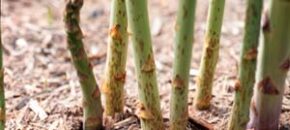Spear damage in asparagus can be caused by diseases such as Phytophthora spear and crown rot and purple spot. However, other environmental factors during the spring can damage spears as they emerge from the soil. Freeze Injury – About 10 days ago temperatures dipped well below freezing for a night or two, and combined with the higher than […]
Continue reading...Webinar: Getting a Head Start and Keeping the Season Going

Register for the Free Informational Talk for Farmers, “Getting a Head Start and Keeping the Season Going,” on Tuesday, May 21, 2024, via Zoom from 6 to 7p.m. For information, call 609-465-5115, ext. 3601 or email capemayag@njaes.rutgers.edu. Register at: https://go.rutgers.edu/unt9odv2
Continue reading...South Jersey Tree Fruit Twilight Meeting – II
When: May 21 (Tuesday) @ 5 pm Where: Nichols Orchards: 628 Royal Ave., Franklinville, NJ 08322 Pesticide credits: 1A (5), PP2 (5), and 10 (5)
Continue reading...Controlling Purple Spot on Asparagus Spears

Purple spot, caused the soil-borne fungus, Stemphylium vesicarium, can cause problems in cool, wet springs. Symptoms, just like its name, include numerous, sunken oval-shaped spots on spears during the harvest season and more importantly on ferns and stalks during the summer months as long as conditions are ideal for its development. Twelve hours of wetness […]
Continue reading...Avoid Sunscald Injury in Transplants
Although the weather has been relatively wet these past few weeks, hotter than normal temperatures have already crept in, thus we need to be cautious about sunscald developing on the stems of transplants, especially those being set onto black plastic mulch. With a little planning ahead potential losses to sunscald injury can reduced significantly. A […]
Continue reading...IPM Update 5/08/24
Sweet Corn IPM personnel have deployed black light and corn earworm (CEW) pheromone trap networks in central and northern New Jersey counties. In areas from central Burlington County southward, grower cooperators have been provided with CEW pheromone traps and will be monitoring these traps on their own properties and reporting catch data to IPM personnel. […]
Continue reading...